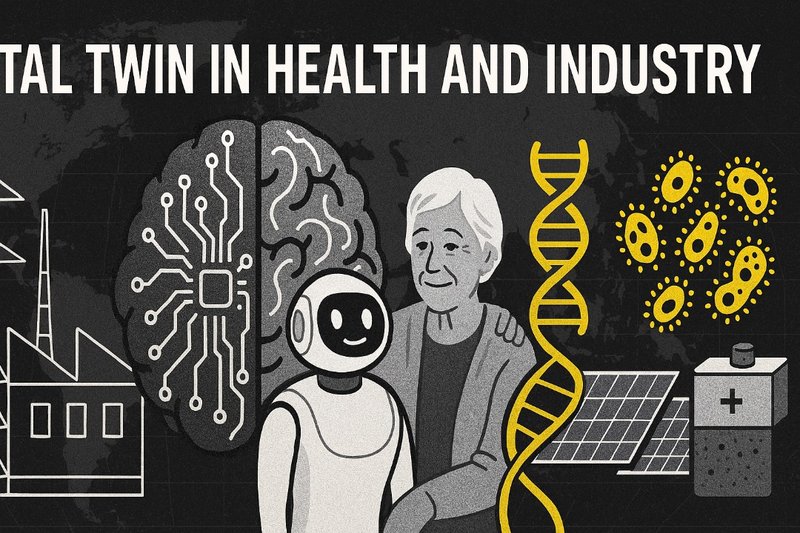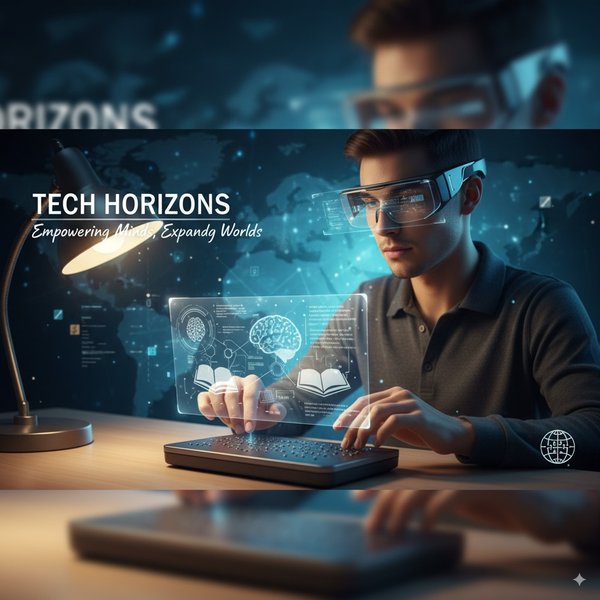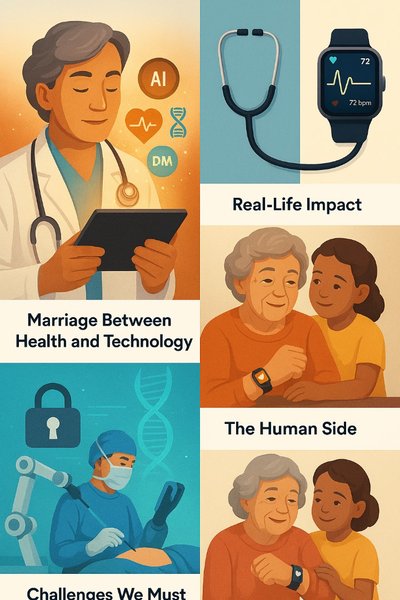Introduction
The world is on the brink of a technological renaissance. From the way we heal diseases to how we interact with machines, technology is evolving at a pace that challenges imagination. What once felt like science fiction is now shaping how industries operate, how humans connect, and how societies grow.
But here’s the truth: the breakthroughs redefining tomorrow aren’t just tools. They are transformations of life itself. They are opening new frontiers in health, education, sustainability, and even human consciousness.
In this article, we’ll explore 15 breakthrough technologies — from digital twins and brain-computer interfaces to living therapeutics and socially assistive robots — that are already reshaping the global stage. For each one, we’ll break down what it is, why it matters, and where you can dive deeper if you want to explore the cutting-edge research driving it forward.
Let’s step into the future.
1. Digital Twins: The Mirror of Reality
Imagine having a perfect digital copy of a factory, a city, or even your own body. That’s the promise of digital twins — real-time digital models that simulate, predict, and optimize physical systems.
-
In manufacturing, digital twins help reduce downtime and optimize production.
-
In healthcare, doctors can simulate how a treatment will affect a patient before prescribing it.
-
Cities use them for smarter infrastructure and sustainability planning.
The impact? Massive cost savings, predictive insights, and accelerated innovation.
📖 Further Reading: IBM on Digital Twins
2. Brain-Computer Interfaces: Bridging Mind and Machine
Brain-Computer Interfaces (BCIs) turn thought into action by enabling direct communication between the brain and digital systems. This isn’t just futuristic—it’s happening now.
-
Medical breakthroughs: Helping paralyzed patients control prosthetics or computers using thought alone.
-
Communication: Restoring speech for patients with neurological damage.
-
Future potential: Imagine controlling your devices seamlessly with your mind.
As research advances, BCIs could redefine human-computer interaction forever.
📖 Further Reading: Nature on Brain-Computer Interfaces
3. Socially Assistive Robots: Companions That Care
Robots are no longer confined to factories. Socially assistive robots are being designed to provide emotional and practical support — especially in healthcare and elder care.
-
They can remind patients to take medicine.
-
Provide companionship for seniors to reduce loneliness.
-
Support therapists in working with children with autism.
Far from replacing humans, these robots are enhancing care systems where human resources are stretched thin.
📖 Further Reading: IEEE on Assistive Robotics
4. Living Therapeutics: Medicine That Grows Inside You
Instead of swallowing pills, imagine medicine that lives inside your body. Living therapeutics use engineered bacteria or cells that function like “tiny doctors,” continuously working within us.
-
Scientists are designing gut microbes that release insulin for diabetics.
-
Others are programming immune cells to seek and destroy cancer.
This represents a shift from treating symptoms to reprogramming biology itself.
📖 Further Reading: MIT Living Therapeutics Initiative
5. Quantum Computing: Cracking the Unsolvable
Traditional computers hit limits when solving problems of massive complexity. Quantum computers harness the laws of quantum mechanics to perform calculations once thought impossible.
-
Drug discovery could accelerate by simulating molecules in ways classical computers can’t.
-
Financial modeling, logistics, and climate predictions could become dramatically faster and more accurate.
While we are still early in adoption, the future potential is nothing short of revolutionary.
📖 Further Reading: Google Quantum AI
6. Green Hydrogen: Fueling the Next Energy Revolution
As the world seeks cleaner energy, green hydrogen is emerging as a powerful alternative. Produced using renewable electricity, it can power vehicles, store energy, and replace fossil fuels in heavy industry.
-
Transportation: Hydrogen fuel cells are powering buses, trains, and ships.
-
Industry: Steel and cement production could move away from coal.
Green hydrogen may be the missing link in the renewable energy puzzle.
📖 Further Reading: IEA on Hydrogen
7. CRISPR and Gene Editing: Rewriting Life’s Code
CRISPR technology allows scientists to edit DNA with precision. It holds the potential to eliminate genetic diseases, boost crop resilience, and even slow aging.
-
Curing sickle-cell anemia is now becoming reality.
-
Crops engineered to resist pests reduce reliance on harmful pesticides.
It’s powerful and controversial, but undeniably one of the most transformative technologies in human history.
📖 Further Reading: Broad Institute CRISPR Overview
8. 6G Networks: The Next Leap in Connectivity
5G is still rolling out globally, but research into 6G networks is already underway. Promising speeds 100 times faster than 5G, 6G will enable:
-
Seamless immersive VR/AR experiences.
-
Real-time AI-powered smart cities.
-
Hyper-connected Internet of Things (IoT) ecosystems.
Connectivity will be so fast it will blur the boundary between digital and physical worlds.
📖 Further Reading: Ericsson on 6G
9. Personalized Medicine: Healthcare Designed for You
One-size-fits-all healthcare is fading. Personalized medicine uses genetic and lifestyle data to design treatment unique to each individual.
-
Cancer therapies are now tailored to the genetic profile of tumors.
-
Wearables track health data and alert users to early warning signs.
This approach not only improves outcomes but also reduces unnecessary treatments.
📖 Further Reading: NIH Precision Medicine
10. Neuromorphic Chips: Computers That Think Like Us
Today’s computers process information differently than the human brain. Neuromorphic chips mimic neural networks, offering massive efficiency gains for AI.
-
Potential to run AI with far lower power.
-
Useful in robotics, edge devices, and even medical implants.
This makes computing more “brain-like” — smarter, faster, and more energy efficient.
📖 Further Reading: Intel on Neuromorphic Computing
11. Fusion Energy: The Sun in a Bottle
For decades, fusion power has been the holy grail of clean energy. Now, breakthroughs suggest it might finally be within reach.
-
Fusion promises almost limitless clean energy with no harmful waste.
-
Recent experiments have achieved net-positive energy output for the first time.
If commercialized, fusion could transform global energy forever.
📖 Further Reading: ITER Fusion Project
12. Synthetic Biology: Building Life from Scratch
Synthetic biology enables scientists to design and construct new biological parts and systems.
-
Engineered microbes can produce biofuels, plastics, and pharmaceuticals.
-
It’s already reshaping agriculture, healthcare, and materials science.
This field blurs the line between biology and engineering.
📖 Further Reading: Synthetic Biology at Nature
13. Extended Reality (XR): The Future of Human Experience
XR — a blend of AR, VR, and MR — is revolutionizing how we experience reality.
-
Education: Students can explore ancient civilizations in VR.
-
Work: Companies hold virtual meetings in immersive spaces.
-
Entertainment: Movies and gaming evolve into fully interactive worlds.
It is creating new ways of learning, working, and connecting.
📖 Further Reading: PwC Report on XR
14. Carbon Capture and Storage: Cleaning the Atmosphere
Climate change demands bold solutions. Carbon capture and storage (CCS) pulls CO₂ out of the atmosphere and locks it underground.
-
Oil and gas companies are investing heavily in CCS.
-
Scientists argue it’s critical to meeting climate goals.
While not a silver bullet, CCS is a key piece of the climate solution.
📖 Further Reading: UN on Carbon Capture
15. Biodegradable Electronics: Tech Without the E-Waste
The future of electronics is not just smarter but also sustainable. Biodegradable electronics dissolve safely after use, reducing e-waste.
-
Medical implants that safely disappear after healing.
-
Consumer gadgets designed to decompose instead of polluting landfills.
This represents the next frontier in sustainable innovation.
📖 Further Reading: ScienceDirect on Biodegradable Electronics
Conclusion: The Future Is Already Here
These 15 breakthroughs aren’t just abstract ideas. They are actively shaping economies, industries, and daily lives worldwide. For entrepreneurs, they open new opportunities. For students, they provide pathways to the careers of tomorrow. For society, they promise both challenges and hope.
Technology is more than progress — it’s possibility. The real question is not whether these breakthroughs will arrive, but how ready we are to embrace them.
Tomorrow is being written today. Are you ready to be part of it??




Comments (0)
Leave a Comment
No comments yet. Be the first to comment!